
Shifting towards a circular economy is the next step in the industrial revolution
Today is Earth Overshoot Day. Our earth is exhausted. Today we take more from nature’s resources than our planet can provide. Clearly, that fact alone means we have to stop using finite resources and look for ways to reduce the environmental footprint of the leather industry. Therefore it is important to focus on redesigning our products and processes by using responsible chemistry and resourcing. In this article, I share my thoughts on what I see as the unavoidable transition to a circular economy, and what companies can do to contribute to a better planet.
As a Green Technology Chemist at Stahl, I spend my time thinking about how we can redesign products and processes so they align with the circular way of thinking. How we can make smarter and better use of raw and semi-finished materials, reducing our impact in the value chain, while supporting our customers with possible solutions with regards to prolonged usage, reuse, refurbish and recycling of their products.
Sustainability is a broad topic, but the keywords that recur in my work include things like “bio-based materials”, “closed loop materials”, “circular economy”, “emission reduction” and the replacement of toxic chemicals and processes.
New models, technologies and cooperation
For a long time, we believed that raw material supplies were limitless. Now it is clear that they are not, and that we must make the transition to a circular economy. But how? How can we make the switch?
The key thing to understand is that the move to a circular economy not only requires new business and market models, it also requires changes to the value system and technological innovation. It involves cooperating, evaluating and re-evaluating to steer the economy in the right direction. Designing for the circular economy is an all-new process and sometimes you have to step outside your comfort zone to be able to develop circular products and processes. You have to take your time to do research and explore. And to quote Amy Edmondson: “We’ve got to be willing to fail - smart failures are needed to learn things and to learn them fast.”
This is certainly something we have found to be true at Stahl. We know we cannot change the world by ourselves and that we need to take one step at a time. That’s not defeatist, it’s realistic, because it enables us to build trust and develop a solid foundation on which to talk about and move forward on greener technologies with our customers and partners.
One step at a time
The nature of a circular economy makes trust and collaboration crucial. This is because each part of the value chain is connected. We can only solve the overall problem if we understand the individual challenges. The idea is to retain as much of their value as possible and so reduce, and if possible exclude, the need for virgin materials. This means looking at the whole lifecycle of a product, from raw material sourcing through its use to the disposal of the end product after usage, to determine where we can minimize the amount of virgin materials involved and how we can we limit the environmental, economic and social impact. I often use the diagram below to explain the process.

Within the circular economy, our challenge is to explore and identify where in the lifecycle we can reduce the impact of a product. The complexity of a circular economy, in which everything is connected, makes it inevitable that you can only take one step at a time. The driver is to focus on what you can do and should do rather than of what you can’t.
This is exactly what we do at Stahl, and I would like to use this to illustrate the improvement opportunities I see and explain a few of the steps we have taken towards a circular economy.
Closing the loop in a world of complex products
In a perfect circular world, we could simply de-atomise our products and reuse all our materials, with no new virgin materials required. Unfortunately, the real world is more complex. To be specific, products are more complex.
Combining different materials has delivered our current standard of living, but it also makes changing to a circular economy more challenging. Re-evaluating materials and their use is going to be key in making the transition to a circular economy. For simple products made from one type of material – such as glass, paper, textiles, metal or plastics – recycling, including chemical recycling, and biological recycling (composting) will be key. For complex products, end of life management is more challenging, and will requiring more extensive research. Switching to more sustainable raw materials is a good starting point, while working on end-of-life solutions.
This is also the case for most of Stahl’s products. The wide range of customer applications and the complexity of for example a (polyurethane) coating, makes it difficult to find a one-fits -all solution to close the loop. Using biomass or carbon dioxide as the source of our materials is a start, reducing the impact of our products at the end of their lives. It of course does not stop there and we need to find individual end-of-life solutions for each application.
Renewable raw materials enhance our chemical toolbox
It is important to emphasize that sustainable developments are not incremental innovations. The transition to fully renewable materials is a path that requires new technologies, collaboration and compromises. We see this as an area in which Stahl can have a significant positive impact. As facilitators of renewable feedstock solutions, we can help society decouple growth from fossil carbon-based resource consumption and support de-fossilization.
We are introducing dedicated product lines that offer a more sustainable choice to conventional market alternatives without compromising on functional performance. This approach includes improving the sustainability profile of our product portfolio by incorporating more recycled and bio-based feedstocks upstream. We also design solutions to have a lower downstream environmental impact than conventional products, for example by minimizing water consumption and ensuring higher water quality.
The novel properties of these renewable materials will add new tools to our chemical toolbox and make it possible to solve problems we experience now. We are in a transition phase in which, from a technical and chemical point of view, the opportunities are endless.
Collaboration is the key to a successful transition
At Stahl, we believe in the long-term potential of renewable feedstock chemistry. We want to be the driving force behind this industry-wide transformation – by not only helping our customers meet growing consumer demand for products that help to protect the environment but also driving awareness and sharing important technical know-how on developing solutions.
Collaboration is the cornerstone of our efforts to drive renewable feedstock chemistry forward. By working with like-minded partners across industries and advocating for the wider adoption of renewable chemistry solutions, we can multiply the positive impact of our science and innovation for the benefit of society at large.
Shift towards even more sustainable materials
We are also supporting the development of alternative, sustainable materials, such as materials made from mushrooms, fruit and jellyfish, plus other organic, natural ingredients. These are all sustainable materials whose properties we can improve. Make them more durable, for example, or give them the specific aesthetics a brand or certain consumers value in a product. It is a great example of how working together within our supply chain contributes to a better planet!
Find the world at your feet
As Stahl, we are convinced that the best way for our industry to achieve a sustainable future is via transparency and cooperation in the supply chain. I am proud that this way of thinking is embedded in our daily business, and that we are working on new ways to contribute to the environment by collaborating with industry peers and universities, taking one-step at a time.
The transition to the circular economy will not be easy, but I have faith that we will succeed. Personally, as a scientist, I love being part of this and expanding our knowledge bit by bit. I find it fulfilling to contribute to a better planet for the current and future generations. Leading your company towards a more sustainable and responsible future might feel like stepping into uncharted territory, but as we are finding, we believe that those who venture out into the great unknown are those who will find the world at their feet.